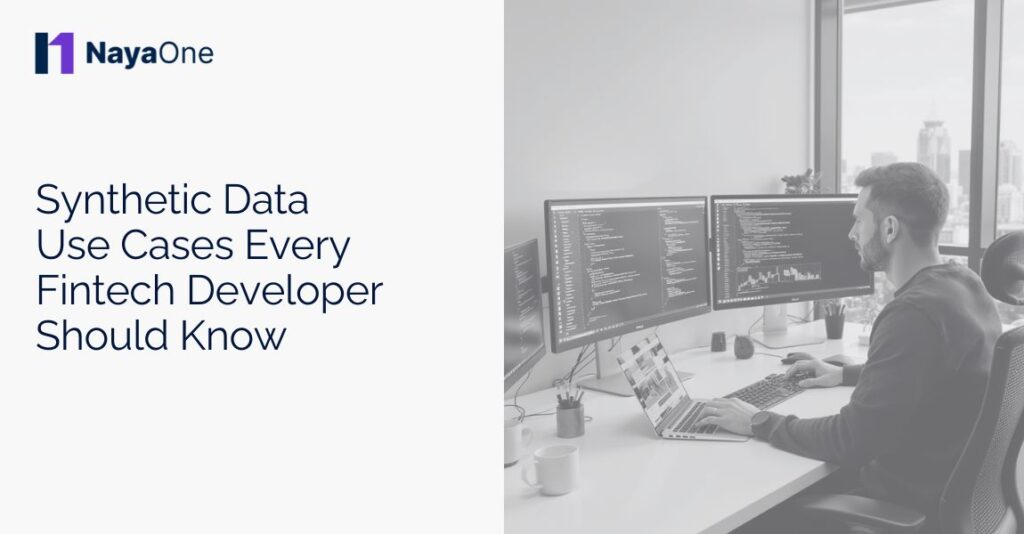Fintech developers are constantly looking for ways to innovate safely, speed up testing, and protect sensitive customer information. This is where synthetic data comes into play. Synthetic data is artificially generated information that mimics the patterns and structure of real financial data without exposing anyone’s personal details. It’s like having a realistic sandbox for your systems, where you can experiment freely and learn quickly.
Understanding synthetic data use cases is essential for fintech teams. From testing new payment flows to training AI models and checking fraud detection algorithms, synthetic data allows developers to innovate confidently. According to a report by MarketsandMarkets, the synthetic data market in financial services is expected to grow at a CAGR of 24.5% from 2025 to 2030, highlighting its increasing importance in fintech innovation.
What is synthetic data, and why does it matter in fintech?
Synthetic data is information generated by computers that imitates real-world financial datasets. Think of it as a “practice environment” for your systems: realistic, flexible, and entirely safe. In fintech, this matters because it allows developers to test new applications, model predictions, or transaction systems without touching actual customer accounts. For example, banks and payment providers can generate thousands of transaction scenarios to see how their systems handle edge cases. This reduces errors in live environments, protects sensitive customer information, and accelerates product development. Regulatory bodies are increasingly recognising synthetic data as a safe alternative for testing while maintaining compliance.
The global synthetic data generation market is projected to grow from USD 351.2 million in 2023 to USD 2,339.8 million by 2030, exhibiting a CAGR of 31.1% during the forecast period. This rapid growth underscores the increasing reliance on synthetic data as essential tools for fostering innovation and ensuring compliance in the rapidly evolving open banking landscape.
How does synthetic data enhance testing and development?
Testing financial systems can be risky. If you use real data, mistakes can impact customers and business operations. Synthetic data provides a safe way to experiment. Developers can simulate thousands of transactions, stress-test APIs, or train AI models without ever exposing real information. This allows teams to explore unusual scenarios, such as sudden spikes in transactions or complex fraud attempts, without jeopardising live systems.
One key advantage is speed. Using synthetic data, fintech teams can iterate on designs quickly, identify bugs, and optimise workflows in a realistic but safe environment. Many platforms also provide analytics and reporting tools, so developers can see exactly how systems respond under different scenarios. This makes development cycles shorter and more reliable. Also, by incorporating synthetic data into automated testing pipelines, teams can continuously validate updates, reduce human error, and maintain higher confidence when deploying new features to production.
Which synthetic data use cases are most common in fintech?
There are several synthetic data use cases that fintech developers rely on to innovate:
- Fraud detection: Developers can simulate fraudulent transactions to test and improve AI models.
- Risk modelling: Synthetic datasets allow banks to predict financial risks without exposing sensitive client data.
- Scenario simulations: Teams can explore “what if” scenarios, like sudden spikes in transactions or market shocks.
- AI and machine learning training: Synthetic data feeds machine learning models safely, improving accuracy without compromising privacy.
- Regulatory compliance testing: Banks can ensure new features meet legal and security standards before deploying them in production.
These use cases show how versatile synthetic data is. It’s not just a testing tool; it’s a foundation for safer, faster, and smarter fintech innovation.
How do fintechs implement synthetic data effectively?
Implementing synthetic data doesn’t have to be complicated. Here’s a practical approach for fintech teams:
- Define objectives: Decide what you need the data for: testing APIs, training models, or simulating transactions.
- Choose the right tools: Select a platform that can generate realistic datasets while integrating with your existing systems.
- Validate synthetic data: Ensure that generated data behaves like real data for accurate testing and training.
- Monitor and analyse: Track how your systems perform with synthetic inputs and adjust your workflows accordingly.
- Integrate into development pipelines: Incorporate synthetic data into CI/CD workflows so testing is continuous, repeatable, and scalable.
A well-implemented synthetic data strategy helps fintechs innovate faster, reduce operational risk, and maintain compliance, all without touching real customer data.
Why fintech developers should embrace synthetic data use cases
Synthetic data isn’t just a testing tool; it’s a game-changer for fintech innovation. By providing safe, realistic datasets, it allows developers to experiment, train AI models, test APIs, and simulate financial scenarios without risk. Teams can explore new features, try out bold ideas, and uncover potential issues before they reach live systems, all in a controlled environment that protects both data and customers.
Embracing synthetic data use cases accelerates development cycles, enhances security, and ensures compliance. It also encourages a culture of experimentation, where developers feel confident iterating quickly and learning from failures without fear. For fintechs looking to stay ahead, it transforms the way teams approach product development, testing, and analytics, ultimately leading to smarter solutions and better services for customers. By integrating synthetic data into everyday workflows, businesses can reduce operational bottlenecks, improve decision-making, and launch innovations that are both reliable and regulatory-ready.
FAQs
Accordion Content
Setup time depends on your systems and objectives. Small-scale implementations may take a few days, while complex enterprise setups with multiple integrations can take several weeks. Clear objectives and planning help streamline the process.
Banks, fintechs, and third-party providers benefit the most. Developers, product teams, and compliance officers can safely test ideas, train models, and optimise systems without exposing sensitive customer information.
No. Synthetic data complements real datasets by providing a safe environment for testing and model training. It allows experimentation and model validation without risk, but real data is still needed for final validation and production use.





